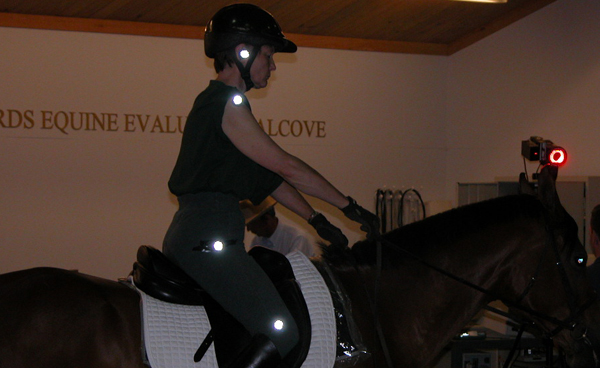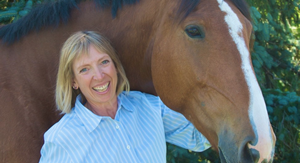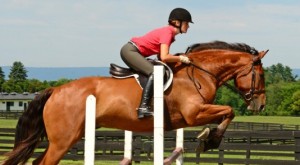Published in Dressage and CT, June 1998
The McPhail Chair Report #1
Like many sports dressage combines elements of art and science. Today’s top competitors have developed the artistic component to a high level, whereas the scientific component is still in its infancy. Biomechanics is an area of science that has many applications in improving sporting performance and safety. This article will explore some of the benefits that have occurred in other sports as a direct result of biomechanical study, and will look at the ways in which dressage could benefit from being studied in a similar manner.
If you found time to watch the Nagano Olympics on television, you may remember seeing animated figures of skaters illustrating how some of the jumps are performed. These computer simulations have been used extensively in sports like gymnastics, diving and skating to visualize new moves and to determine which of these moves are physically possible for a human athlete. For example, one of the prerequisites for a skater to perform a quad jump is the ability to jump high enough to complete the required number of revolutions before returning to the ice. The height achieved depends on the strength of the muscles that propel the body upwards into the air. Without sufficient strength, the airborne time is too short to perform the jump. In dressage airborne movements are generally reserved for the high school, but muscular strength for upward propulsion is still needed to lift the horse into each suspension. Research has shown that lift in the suspension is what gives the horse a long, ground-covering stride in the trot and canter, and horses that are deficient in this aspect will not show breath-taking extensions. In the McPhail Dressage Laboratory we are applying computer modeling to explore the effects of dressage training on different parts of the horse’s body. By understanding the biomechanics of self carriage, collection and extension, we will be able to predict why certain injuries occur and, hopefully, to develop methods of prevention.
Another way in which biomechanical analysis has had profound effects on sports is in the development and application of new materials and equipment. Runners are now able to achieve faster race times while reducing the risk of injuries during their long training miles as a result of improvements in shoe design and cushioning properties. Ground up sneakers are one of our many choices for arena footing, but we don’t really know how different surfaces compare in terms of their effect on the horse’s comfort and safety. We do know that the most common reason for premature retirement of dressage horses is degenerative joint disease (arthritis), which develops as a consequence of the concussion transmitted up the limb each time the hoof strikes the ground. We need more information regarding the relative merits of sand, rubber products and wood fiber products in reducing concussion, in allowing appropriate amount of sliding during impact and in providing sufficient security during the push off.
I could fill several pages describing the potential applications of biomechanical analysis in dressage and the associated benefits to our horses. However, this is all pie in the sky without the necessary financial support. Although there are some excellent foundations dedicated to supporting veterinary research, none of them has been targeted toward performance studies of sport horses. Thanks to the generosity of Mary Anne and Walter McPhail, the situation is now changing. Through an endowment to Michigan State University, the McPhails have established the Mary Anne McPhail Dressage Chair in Equine Sports Medicine. The objective is to foster research that will enhance performance and soundness of dressage horses. I was chosen as the first incumbent of this unique position and started work at MSU in June 1997.
One of the most important responsibilities of the McPhail Dressage Chair is to ensure that the results of our research are conveyed to those who will use them. This will be accomplished through lectures, articles in magazines and regular updating of our web page (see sidebar). This column is the first of a regular series in Dressage and CT that will follow the progress of the McPhail Dressage Laboratory. My goal is to keep readers updated about new findings related to the science of dressage, to indicate how these facts are important in training and producing dressage horses, and to give you a different perspective on our sport and our horses. I hope you enjoy reading the column and look forward to your feedback.
McPhail Dressage Laboratory
The McPhail Dressage Laboratory is run by Joel Lanovaz, a mechanical engineer who did his graduate work under Dr. Clayton’s supervision in Canada. Joel is responsible for operating and maintaining the equipment in the laboratory and for writing our custom software. His special research interests are in computer modeling of the equine limb and in studying the effects of concussion during locomotion. Graduate training is an important aspect of our mission. At present one PhD student, Molly Nicodemus, is working in the lab. Her project will involve three-dimensional studies of limb movements in different gaits. Molly is also the coach of the MSU equestrian team. More graduate students will surely follow as we gather momentum and establish new research directions. A few students visit the lab for periods of 2-6 months to gain experience in gait analysis. Last year Emma Hodson, an equine science student from Hartpury College in England, spent 4 months studying the collected and extended walk and the walk pirouettes. She will return later this year to continue her project.




